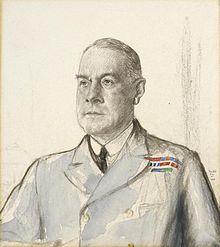Cecil Thursby
| Sir Cecil Thursby | |
|---|---|

1918 portrait by Francis Dodd
|
|
| Born | 16 January 1861 |
| Died | 28 May 1936 (age 75) Great Ryton, Dorrington, Shropshire |
| Allegiance |
|
| Service/branch |
|
| Years of service | 1874 - 1920 |
| Rank | Admiral |
| Commands held |
HMS King Alfred HMS Swiftsure 3rd Battle Squadron 5th Battle Squadron 2nd Squadron British Adriatic Squadron East Mediterranean Coastguards and Reserves Plymouth Command |
| Battles/wars | World War I |
| Awards |
Knight Commander of the Order of the Bath Knight Commander of the Order of St Michael and St George |
Admiral Sir Cecil Fiennes Thursby, KCB, KCMG (17 January 1861 – 28 May 1936) was a Royal Navy officer who went on to be Commander-in-Chief, Plymouth, after serving in World War I mainly in the Mediterranean Sea.
Thursby was born in Warwickshire, son of Church of England clergyman the Reverend Walter Thursby (died 1868).
He married in 1899 Constance Ann, daughter of Cressett Thursby-Pelham of Cound, Shropshire. The couple had a son and daughter.
Thursby joined the Royal Navy, aged twelve, in 1874, training on HMS Britannia. He was present as a midshipman during the engagement with the Peruvian rebel ship Huáscar in 1877 and also took part in the Niger expedition in 1882, as well as the Suakim Expedition to the Sudan in 1884-85 as Lieutenant aboard HMS Tyne. In 1890, he earned a certificate from the Royal Humane Society for rescuing a drowning man off Cowes, Isle of Wight.
Promoted captain on 31 December 1901, he was appointed in command of the battleship HMS Triumph on 16 July 1902. He commanded the cruiser HMS King Alfred and later the battleship HMS Swiftsure, from which he commanded a detached squadron in the eastern Mediterranean during a time of massacres by Turks in Asia Minor in 1909, gaining the thanks of the Admiralty and Foreign Office for protecting life and property. He commanded the International Squadron in Crete in 1910, earning thanks from four Great Powers for pacifying the island (which had not long united with Greece) and became Commodore at the Royal Naval Barracks at Chatham later that year. He went on to be Rear Admiral commanding the 3rd Battle Squadron in 1912.
...
Wikipedia
